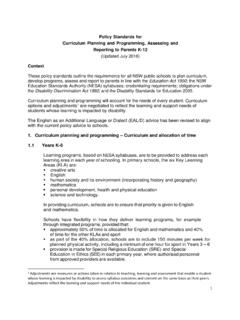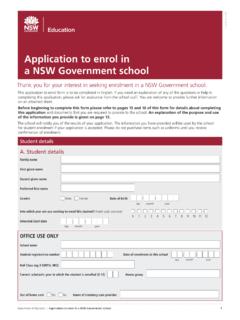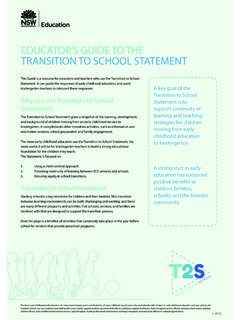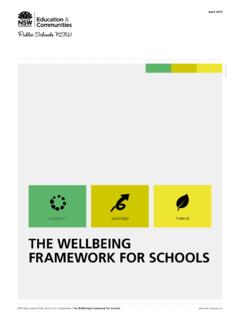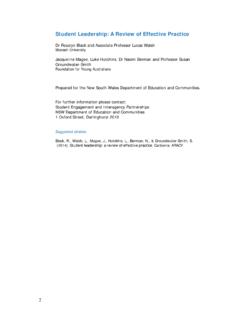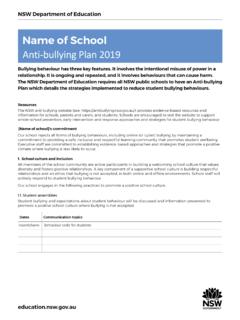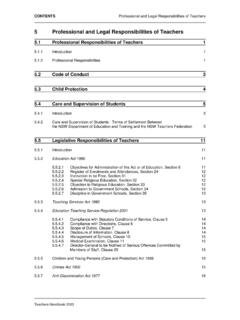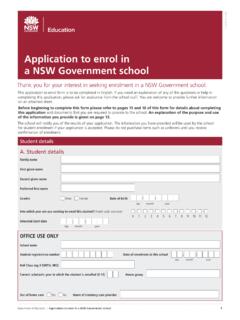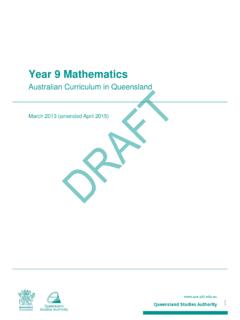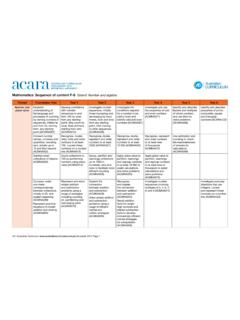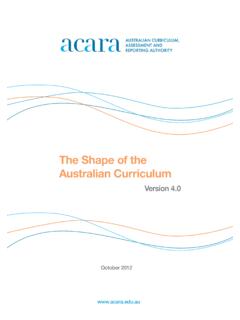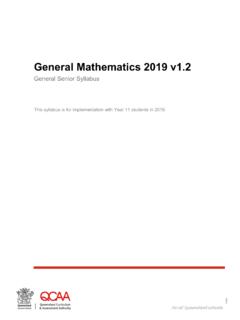Transcription of Teaching About Angles - education.nsw.gov.au
1 PRO U O A D CU CULUM I EC Teaching About Angles Stage 2. Acknowledgments Associate Professor Mike Mitchelmore, australian Centre for Educational Studies, and Dr Paul White, australian Catholic University, for their development of the Teaching sequence, background notes and classroom activities featured in this document. Board of Studies, NSW, for permission to include the outcomes from the mathematics K 6 Syllabus, 2002, Board of Studies, NSW. Graphic Design: Aston Hunt Design Services Teaching About Angles : Stage 2. State of NSW. 2003, Department of Education and Training Professional Support and Curriculum Directorate Restricted waiver of copyright State of NSW, Department of Education and Training, Professional Support and Curriculum Directorate 2003. Downloading, copying or printing of materials in this document for personal use or on behalf of another person is permitted. Downloading, copying or printing of material from this document for the purpose of reproduction or publication (in whole or in part) for financial benefit is not permitted without express authorisation.
2 ISBN 0731382773. SCIS 1146249. Additional copies are available for sale from: DET Sales PO Box 22. BANKSTOWN NSW 2200. Telephone: (02) 9793 3086. Facsimile: (02) 9793 3242. 2 Teaching About Angles : Stage 2. Foreword Watching a group of young people playing basketball reminds you of why youth is sometimes described as angular. Elbows and knees present a constantly changing landscape of Angles . The basketball sometimes moves up and down as it is dribbled on the spot only to move forward in a remarkable way as the player moves rapidly forward. Angles form and quickly reform as players jockey for position to pick up the rebound. The angular nature of a basketball game is not restricted to the players. The referee puts his hands on his hips to signal a blocking foul and we see two-armed Angles aplenty. The second hand on the shot-clock sweeps out its own one-armed Angles before the shot misses and rebounds off the backboard.
3 When we talk About Angles it is not always clear what we are describing. For many students the angle is the pointy bit . For yet other students, the angle is the arms . and longer arms can mean bigger Angles ! Teaching About Angles : Stage 2 is a collection of practical lessons designed to assist students to understand what we mean by Angles . The materials provide opportunities for students to abstract the angle concept from a range of situations where they can initially see both arms of the angle, then only one arm and finally where they need to imagine both arms of the angle as in the rebound of a ball. All of the lessons have been trialled and I commend Teaching About Angles : Stage 2 to you as a practical resource to assist with Teaching two-dimensional space in the new mathematics K 6. syllabus. Janet Davy R/Director Professonal Support and Curriculum Directorate Teaching About Angles : Stage 2 3. 4 Teaching About Angles : Stage 2.
4 Contents Page Learning About Angles 7. Using this book 8. Sequence of Angles lessons 9. Teaching materials 10. Student assessment 11. Glossary 11. The lessons About Angles 1 Pattern blocks 12. 2 Windmill patterns 14. 3 Square corners 16. 4 Acute and obtuse Angles 18. 5 Angles in geometrical patterns 20. 6 Equal Angles 22. 7 Measuring pattern block Angles 24. 8 Measuring Angles in the classroom 26. 9 Measuring body Angles 28. 10 Drawing two-line Angles 30. 11 Measuring the angle of opening of doors 32. 12 Doors that open in different directions 34. 13 Measuring Angles of slope 36. 14 Clocks 38. 15 Drawing two-line and one-line Angles 40. Activity sheets Pentagram for lesson 5 42. Octagon for lesson 5 43. Windmill for lessons 6, 7 and 8 44. Pattern blocks for lesson 7 45. Body Angles for lesson 9 46. Drawing two-line Angles for lesson 10 47. House for lessons 11 and 12 49. Slopes for lesson 13 50. Clock face for lesson 14 51.
5 Clock Angles for lesson 14 52. Task cards for lesson 15 53. Two-line angle tasks 54. Two-line angle recording sheet 55. Two-line and one-line angle tasks 56. Two-line and one-line angle recording sheet 57. Teaching About Angles : Stage 2 5. 6 Teaching About Angles : Stage 2. Learning About Angles Together with length, angle is possibly the most important tool used to describe shapes in construction, design and navigation. Angle also plays an important role in developing students' understanding of geometry. It is therefore vital that students obtain a good understanding of the concepts of angle at an early stage. Angles arise in many different contexts. They are used to describe the shape of the corner of a geometrical figure, to specify direction, an amount of turning or opening, and an inclination or slope. This can make Angles an interesting topic to teach, because the teacher can draw on many examples in the students' environment.
6 However, Angles arise in different ways in different situations, and this can make the topic challenging for students to learn. The easiest Angles for students to learn About are two-line Angles , in which both arms of the angle are visible. These Angles are found in the corners of geometrical figures and corners and intersections in our environment, such as the corners of a room. Another important group of Angles may be described as one-line Angles . In these Angles , only one arm of the angle is clearly visible. The other line of the angle must be imagined or remembered. Objects which can form one-line Angles include an opening door, when there is no line on the floor to indicate the closed position of the door. Other examples are the turning of each hand of a clock and the slope on a roof or an incline where the horizontal line has to be visualised. Many Angles arise from situations in which neither arm of the angle is visible.
7 A. spinning ball and a turning wheel are examples of no-line Angles . A major challenge in learning About Angles is to recognise that the same idea is present in many different situations. Some two-line Angles are horizontal (the corner of a table top); some are vertical (the corner of a window frame), some are solid (furniture corners) and some are empty (lattice work). Some Angles are fixed (picture frames) and some are movable (a pair of scissors). In some cases the two lines are easy to detect (sharp corners) and in others they are more difficult to discern (rounded corners). Students need to recognise that Angles in all these objects are similar in that they consist of two linear parts that cross or meet at a point. They are also similar in that the relative inclination of these two parts has some significance; it defines the sharpness of the corner or the openness of the arms. Further challenges arise when students encounter one-line Angles .
8 To form an angle, a second line must be constructed and this second line varies according to the context. To describe the opening of a door using Angles , the closed position of the door must be remembered or imagined. To describe the turning of a clock hand using Angles , the starting position must be used even if there is no hand there. To describe the slope of a roof using Angles , a horizontal line must be found in the vicinity or simply imagined. Because the second line is different in each case, one-line Angles are more difficult than two-line Angles , and no-line Angles are even more difficult. The concept of angle is abstracted from the similarities between many different angle situations. The three critical features of this similarity are: two line, the arms of the angle a point where the lines meet, the vertex a degree of openness between the line, the size of the angle. The angle concept is the embodiment of this similarity.
9 Teaching About Angles : Stage 2 7. Using this book Overview This book provides support for Teaching About Angles in Stage 2 or the middle primary years. Students learn About : identifying two-line Angles identifying the arms and vertex of one-line Angles comparing Angles using informal means such as angle testers describing Angles using everyday language and mathematical terms right, acute and obtuse. Students learn to work mathematically with these ideas using the processes of questioning, reflecting, communicating, applying strategies and reasoning. The lessons Each lesson commences with a general, teacher-led discussion leading into a new idea. The discussion is followed by one or more small-group activities in which students explore the new idea and its properties and consequences. The lesson concludes with another whole-class, teacher-led discussion in which the results of the student activities are highlighted and summarised.
10 The lessons focus on the Teaching of a few key ideas that are clearly identified in the accompanying notes. Teachers are encouraged to adapt or adjust the suggested lesson ideas, to ensure that the program is appropriate to their students' current knowledge and understanding. Extension activities have been included in many of the lessons. Programming the lessons The fifteen lessons are presented in a suggested Teaching sequence and in three major groups under the headings of: Introduction to two-line Angles Measuring two-line Angles Measuring one-line Angles . The fifteen lessons, together with suggested extension activities, are intended to be sufficient for a Stage 2 program. Lessons from the first two groups, Introduction to two-line Angles and Measuring two-line Angles , would be suitable for students who are commencing a study of Angles . A program that commences at lesson 8 or lesson 9 and continues to lesson 15 would be suitable for students who have been introduced to identifying and measuring two- arm Angles in previous work.
